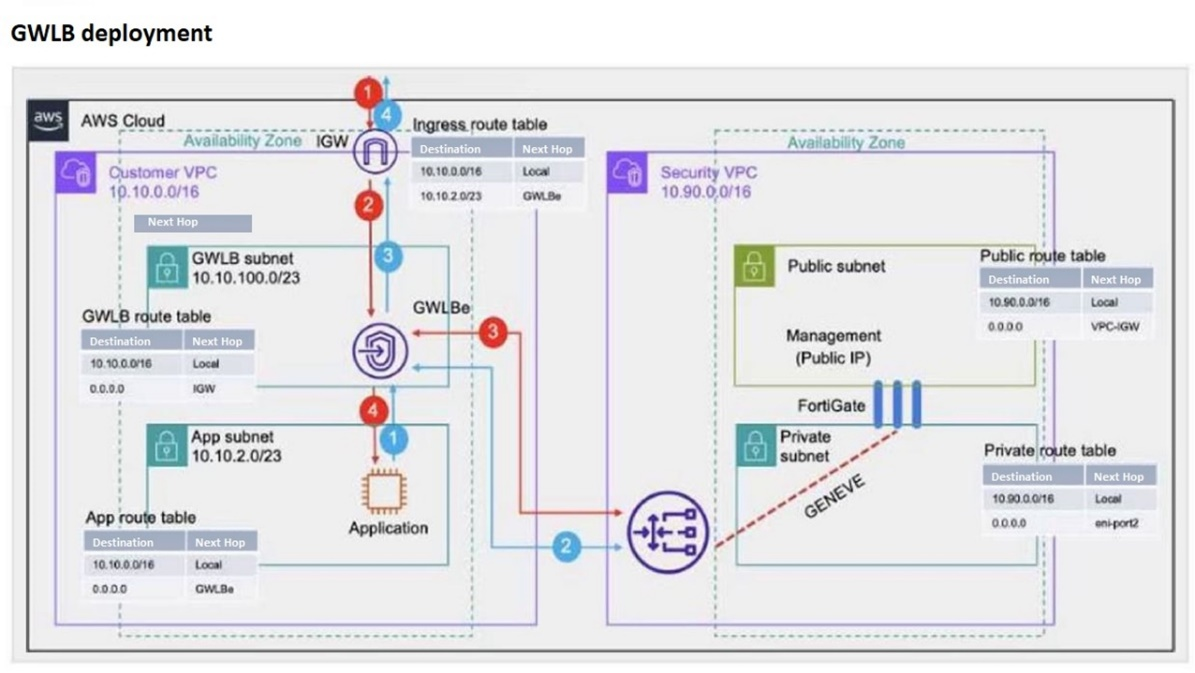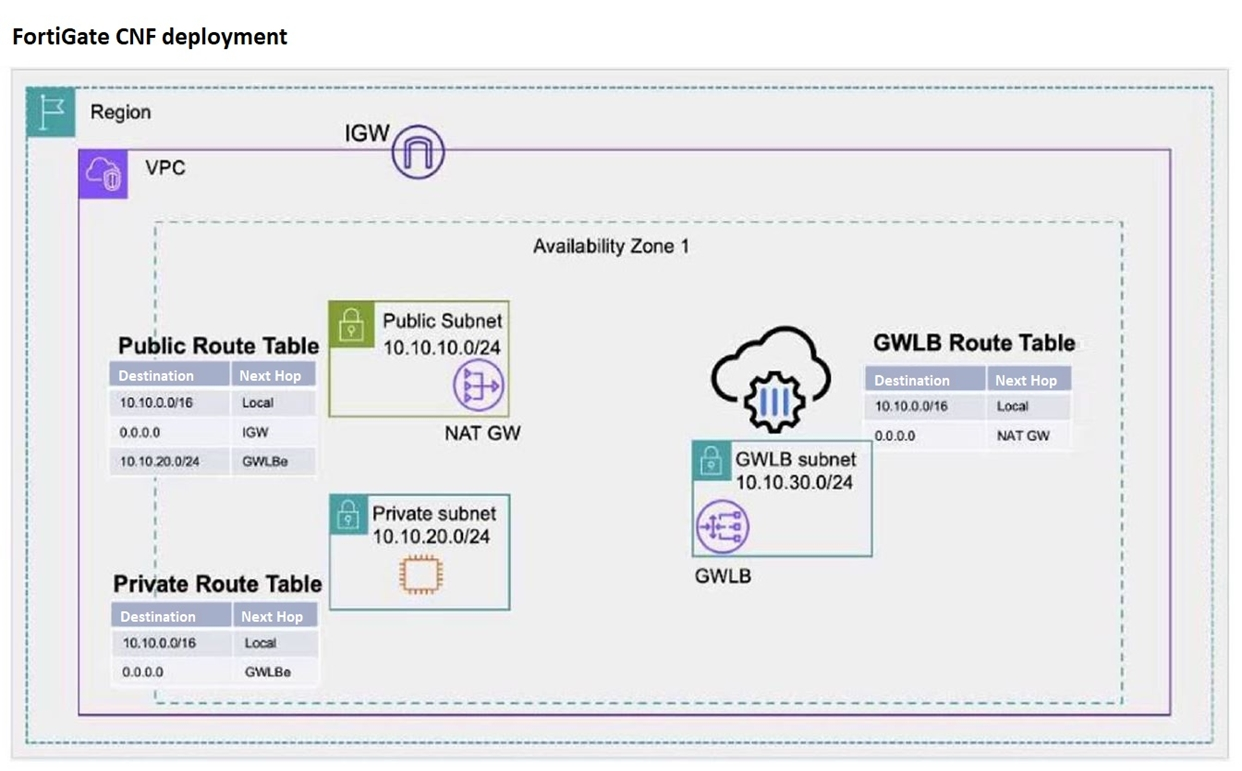Fortinet FCP - AWS Cloud Security 7.4 Administrator FCP_WCS_AD-7.4 Exam Practice Test
Which two statements about the FortiCloud portal are true? (Choose two.)
Answer : A, C
Remote Access to FortiGate VM:
The FortiCloud portal allows users to remotely access their FortiGate VM instances. This is particularly useful for managing and configuring instances without needing direct network access (Option A).
FortiFlex Portal Access:
The FortiFlex portal is a feature that becomes available only after purchasing a FortiFlex license and registering it on FortiCare. This portal provides additional functionalities and services related to FortiFlex (Option C).
IAM Permissions:
Option B is incorrect because the Identity and Access Management (IAM) permissions in the FortiCloud portal do not require writing JSON scripts; they can be managed through the portal interface.
Subscription to Cloud Services:
Option D is incorrect because FortiCloud provides access to services beyond those subscribed through the AWS marketplace, including services directly offered by Fortinet.
FortiCloud Documentation: FortiCloud
FortiFlex Portal: FortiFlex Licensing
Refer to the exhibit.

What two conclusions can you draw from the FortiGate debug output? (Choose two.)
Answer : A, C
Dynamic Address Object Update:
The debug output shows that the IP address of the AWS Windows Server Lab has been updated automatically, indicating that the dynamic address object feature is working as intended. This allows FortiGate to adapt to changes in the IP addresses of AWS instances dynamically (Option A).
SDN Connector Configuration:
The messages in the debug output confirm that the SDN connector is able to retrieve instance information and update the firewall address objects successfully. This implies that the SDN connector is correctly configured and has the necessary permissions (Option C).
Manual Change and Permissions:
Option B is incorrect because while the address object could theoretically be changed manually, this is not inferred from the debug output.
Option D is incorrect because the debug output does not indicate that the AWS user account must have full administrative rights. The required permissions are typically more scoped to specific actions related to SDN.
FortiGate AWS Integration Guide: FortiGate on AWS
Refer to the exhibit.

Which two statements are true about inbound traffic based on the IGW ingress route table and GWLB deployment shown in the exhibit? (Choose two.)
Answer : B, D
Traffic Direction through GWLB Endpoint:
The ingress route table directs inbound traffic to the GWLB through a GWLB endpoint (GWLBe). This endpoint is responsible for directing traffic to the Gateway Load Balancer for further processing (Option B).
GENEVE Encapsulation:
The GWLB encapsulates the inbound traffic using the GENEVE protocol. This encapsulated traffic is then sent to FortiGate instances for security inspection. The use of GENEVE ensures that the original traffic context is preserved and can be analyzed by FortiGate (Option D).
Other Options Analysis:
Option A is incorrect because GWLB does not forward traffic without encapsulation in its dedicated subnet.
Option C is incorrect as the inbound traffic is directed to the GWLB endpoint first, not directly to the application subnet.
AWS Gateway Load Balancer Documentation: AWS GWLB
GENEVE Protocol Overview: GENEVE Protocol
An administrator needs to attach an Elastic Network Interface (ENI) to an application instance in a VPC with multiple availability zones. An instance runs in availability zone 1.
Which ENI property must the administrator consider when implementing this requirement?
Answer : A
ENI Attachment Across Availability Zones:
Elastic Network Interfaces (ENIs) are associated with a specific Availability Zone. They cannot be attached to instances that are in a different Availability Zone than where the ENI was created. Therefore, an ENI created in Availability Zone 1 cannot be attached to an instance in Availability Zone 2 (Option A).
ENI Reattachment:
ENIs can be detached from one instance and reattached to another instance within the same Availability Zone. This flexibility allows for network interface configuration to be preserved across instance changes within the same AZ.
Other Options Analysis:
Option B is incorrect because an ENI can be reattached to any instance in the same AZ.
Option C is incorrect as the primary ENI (eth0) cannot be detached from an instance.
Option D is incorrect because when an ENI is moved, the traffic is directed to the new instance, and there is no redirection to the old instance.
A customer is attempting to deploy an active-passive high availability (HA) cluster using the software-defined network (SDN) connector in the AWS cloud.
What is an important consideration to ensure a successful formation of HA, failover, and traffic flow?
Answer : C
HA Cluster in AWS Cloud:
Deploying an active-passive HA cluster in AWS requires careful consideration of the clustering protocol used to ensure seamless failover and traffic flow.
Unicast FortiGate Clustering Protocol (FGCP):
Unicast FGCP is specifically designed for environments where multicast traffic is not feasible or supported, such as in the AWS cloud. Using unicast FGCP ensures that heartbeat and synchronization traffic between the cluster members are managed correctly over unicast communication, which is suitable for AWS's network infrastructure (Option C).
Comparison with Other Options:
Option A is incorrect because while placing both cluster members in the same availability zone might be required for certain configurations, it is not the critical factor for HA formation.
Option B is incorrect as VDOM exceptions are not directly related to the successful formation of HA.
Option D is incorrect because the ELB configuration checks are more about ensuring that the load balancer correctly routes traffic but do not specifically ensure HA formation and failover.
FortiGate HA in AWS Documentation: FortiGate HA
Fortinet FGCP Details: FGCP Documentation
Refer to the exhibit.

Traffic is initiated from the EC2 instance and is destined for the internet.
Which traffic flow is correct?
Answer : C
Understanding the Architecture:
The architecture includes an EC2 instance in a private subnet, a Gateway Load Balancer Endpoint (GWLBe), a NAT Gateway (NAT GW), and an Internet Gateway (IGW).
Route Tables and Routing:
The private route table for the subnet containing the EC2 instance has a route pointing to the GWLBe for internet-bound traffic.
The public route table for the subnet containing the NAT Gateway has routes to the IGW.
Traffic Flow Analysis:
Traffic initiated from the EC2 instance destined for the internet will first be routed to the GWLBe as per the private route table.
The GWLBe will forward the traffic to the NAT Gateway.
The NAT Gateway will then route the traffic to the IGW, which finally sends the traffic to the internet.
Comparison with Other Options:
Option A suggests direct routing to the NAT GW from the EC2 instance, which is incorrect.
Option B incorrectly states there is no route to the internet in the private route table.
Option D suggests direct routing from GWLBe to the internet, which is not the case.
Your customers have been reporting slow response times when accessing your web application.
What are two possible ways to increase response times from web servers protected by FortiWeb Cloud? (Choose two.)
Your customers have been reporting slow response times when accessing your web application.
What are two possible ways to increase response times from web servers protected by FortiWeb Cloud? (Choose two.)
Answer : A, B
Same Region Deployment:
Deploying FortiWeb Cloud in the same AWS region as your web application minimizes latency and ensures faster response times by reducing the distance data needs to travel (Option A).
Content Delivery Network (CDN):
Enabling a CDN can significantly improve response times by caching content closer to the end-users, reducing the load on the origin server, and speeding up content delivery (Option B).
Other Options Analysis:
Option C is incorrect because modifying DNS entries to directly point to your web server bypasses the WAF protection, which is not advisable for security reasons.
Option D is incorrect because disabling WAF functionality would expose your web application to vulnerabilities and threats, compromising security.